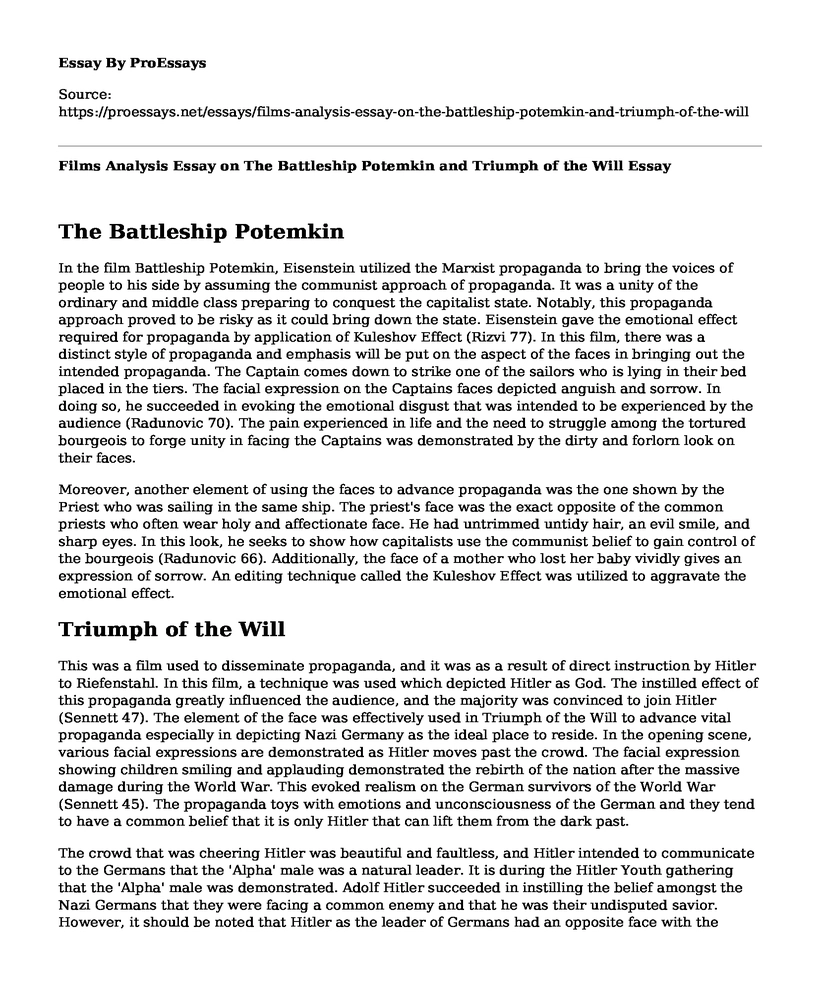The Battleship Potemkin
In the film Battleship Potemkin, Eisenstein utilized the Marxist propaganda to bring the voices of people to his side by assuming the communist approach of propaganda. It was a unity of the ordinary and middle class preparing to conquest the capitalist state. Notably, this propaganda approach proved to be risky as it could bring down the state. Eisenstein gave the emotional effect required for propaganda by application of Kuleshov Effect (Rizvi 77). In this film, there was a distinct style of propaganda and emphasis will be put on the aspect of the faces in bringing out the intended propaganda. The Captain comes down to strike one of the sailors who is lying in their bed placed in the tiers. The facial expression on the Captains faces depicted anguish and sorrow. In doing so, he succeeded in evoking the emotional disgust that was intended to be experienced by the audience (Radunovic 70). The pain experienced in life and the need to struggle among the tortured bourgeois to forge unity in facing the Captains was demonstrated by the dirty and forlorn look on their faces.
Moreover, another element of using the faces to advance propaganda was the one shown by the Priest who was sailing in the same ship. The priest's face was the exact opposite of the common priests who often wear holy and affectionate face. He had untrimmed untidy hair, an evil smile, and sharp eyes. In this look, he seeks to show how capitalists use the communist belief to gain control of the bourgeois (Radunovic 66). Additionally, the face of a mother who lost her baby vividly gives an expression of sorrow. An editing technique called the Kuleshov Effect was utilized to aggravate the emotional effect.
Triumph of the Will
This was a film used to disseminate propaganda, and it was as a result of direct instruction by Hitler to Riefenstahl. In this film, a technique was used which depicted Hitler as God. The instilled effect of this propaganda greatly influenced the audience, and the majority was convinced to join Hitler (Sennett 47). The element of the face was effectively used in Triumph of the Will to advance vital propaganda especially in depicting Nazi Germany as the ideal place to reside. In the opening scene, various facial expressions are demonstrated as Hitler moves past the crowd. The facial expression showing children smiling and applauding demonstrated the rebirth of the nation after the massive damage during the World War. This evoked realism on the German survivors of the World War (Sennett 45). The propaganda toys with emotions and unconsciousness of the German and they tend to have a common belief that it is only Hitler that can lift them from the dark past.
The crowd that was cheering Hitler was beautiful and faultless, and Hitler intended to communicate to the Germans that the 'Alpha' male was a natural leader. It is during the Hitler Youth gathering that the 'Alpha' male was demonstrated. Adolf Hitler succeeded in instilling the belief amongst the Nazi Germans that they were facing a common enemy and that he was their undisputed savior. However, it should be noted that Hitler as the leader of Germans had an opposite face with the expression of 'Alpha' male. He made sure that he looked different from his followers and appeared to be unique in his leadership (Sennett 53). Adolf Hitler maintained the use of this propaganda to rally the Nazi Germans behind him as he was never disobeyed during his leadership.
Conclusion
In conclusion, the films The Battleship Potemkin and Triumph of the Will were utilized in various ways to depict propaganda. The element of facial expression in both films made them look dangerous in their application (Rizvi 81). They converged in portraying a different outlook of the realities by distorting facts to favor the propagandist advance their ideology and get accepted. Eisenstein and Riefenstahl gave real effect to the propaganda that was expressed in two distinct ideologies.
Works Cited
Rizvi, Wajiha Raza. "Politics, propaganda and film form: Battleship Potemkin (1925) and Triumph of the Will (1935)." Journal of International Communication 20.1 (2014): 77-86.
Sennett, Alan. "Film Propaganda: Triumph of the Will as a Case Study." Framework: The Journal of Cinema and Media55.1 (2014): 45-65.
Radunovic, Dusan. "The Shifting Protocols of the Visible: The Becoming of Sergei Eisenstein's The Battleship Potemkin." Film History 29.2 (2017): 66-90.
Cite this page
Films Analysis Essay on The Battleship Potemkin and Triumph of the Will. (2022, Dec 22). Retrieved from https://proessays.net/essays/films-analysis-essay-on-the-battleship-potemkin-and-triumph-of-the-will
If you are the original author of this essay and no longer wish to have it published on the ProEssays website, please click below to request its removal:
- Film Analysis Essay on Meet the Parents
- Andrew Niccol's Film Gattaca Essay
- The Difference Between Watching a Movie in the Theater and at Home on a Television
- "You Bet Your Life" Television Program Essay Example
- Exploring Hip Hop Music: Beyond Controversies & Social Significance - Essay Sample
- Paper Sample on Studying Hollywood Films: A Research Framework
- Paper on The use of Propaganda and Nationalism in WW1







